George I Burr and Highly Figured Walnut Lowboy
Circa 1720. England
SOLD
Request Information
Follow Us
George I Burr and Highly Figured Walnut Lowboy, Circa 1720. England
The feather and cross banded top is quarter veneered with burr walnut and edged with a cross-grain ovolo-moulding, Similarly, the shaped frieze is fitted with three feather and cross-banded cock-beaded oak lined drawers, which all retain their original gilt brass handles. The lowboy is raised on solid walnut cabriole legs on pad feet.
Condition
Provenance
Private collection, Salisbury
Literature
Dimensions
PREVIOUSLY SOLD
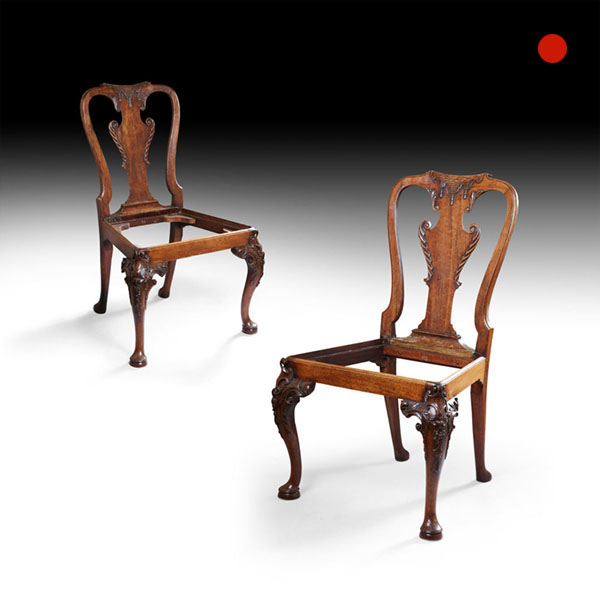
George I Carved Irish Walnut Pair of Chairs
A rare and fine pair of Irish George I walnut side chairs of excellent colour and patina, circa 1720. The undercut shaped back-splats of violin form are beautifully and naturally carved in acanthus leaves, returning into eared scrolls, topped by a crest rail depicting curtain swags and fine hanging passementerie.
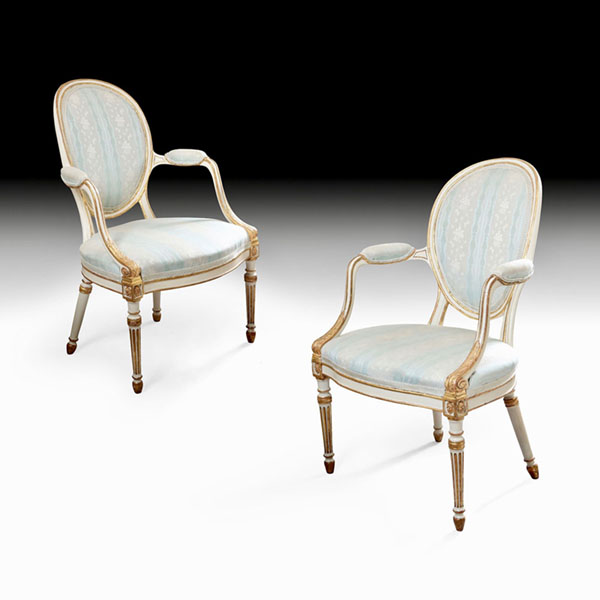
George III Parcel Gilt Painted Pair of Chairs
A fine pair of painted and carved George III English chairs in the French taste, upholstered in silk damask.
Possibly by John Linnell.
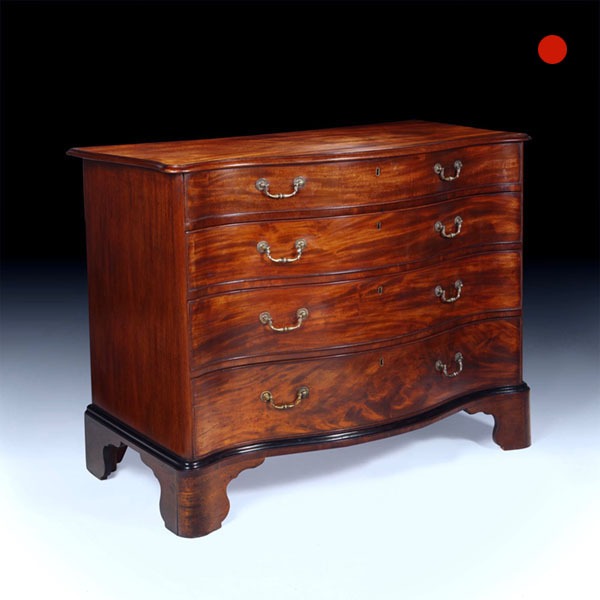
George III Mahogany Serpentine Chest of Drawers
Dating from one of the most famous and highly celebrated periods in English furniture history, now known as the ‘Chippendale period’.
This fine George III mahogany serpentine chest is very much in the manner of Thomas Chippendale.
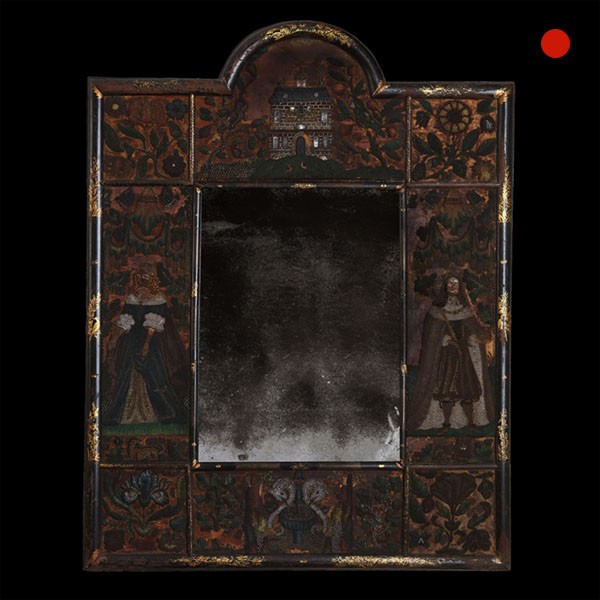
17th-Century Beadwork/Stumpwork Japanned Mirror
Advances in English domestic glass production in the second half of the century coincided with the fashion for stumpwork and resulted in the production of some of the most spectacular examples being produced.
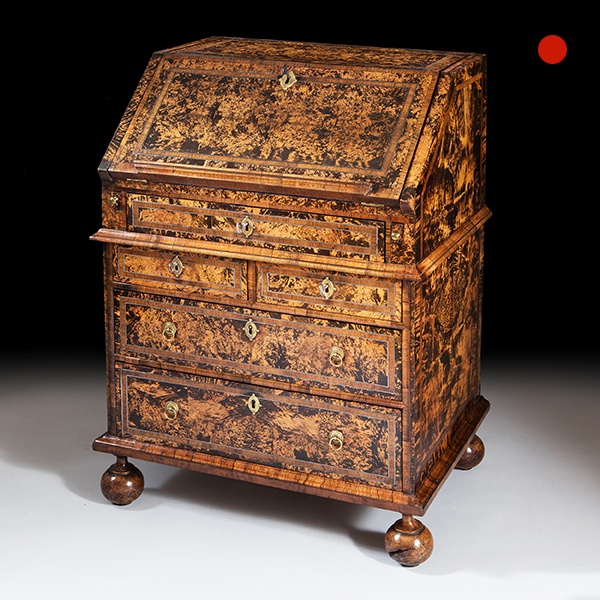
Queen Anne Mulberry Bureau Firmly Attributed to Coxed and Woster, circa 1710 England
Queen Anne Mulberry Bureau Firmly Attributed to Coxed and Woster circa 1710 England SOLD Follow UsQueen Anne Mulberry Bureau Firmly Attributed to Coxed and Woster, circa 1710 England This magnificent Queen Anne 'Mulberry Wood' (field maple) bureau of small proportion...
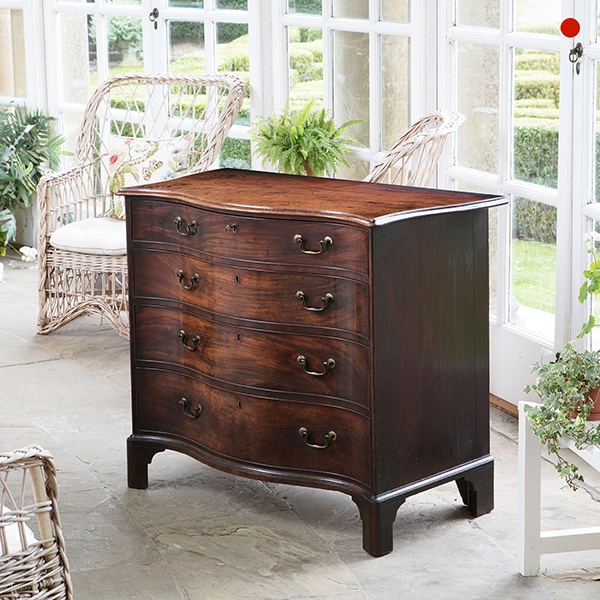
A fine George III mahogany serpentine chest of drawers in the manor of Henry Hill of Marlborough
A fine George III mahogany serpentine chest of drawers in the manner of Henry Hill. With ebonised, ogee moulded serpentine dovetail-housed top.

George I Carved Irish Walnut Pair of Chairs
A rare and fine pair of Irish George I walnut side chairs of excellent colour and patina, circa 1720. The undercut shaped back-splats of violin form are beautifully and naturally carved in acanthus leaves, returning into eared scrolls, topped by a crest rail depicting curtain swags and fine hanging passementerie.

George III Parcel Gilt Painted Pair of Chairs
A fine pair of painted and carved George III English chairs in the French taste, upholstered in silk damask.
Possibly by John Linnell.

George III Mahogany Serpentine Chest of Drawers
Dating from one of the most famous and highly celebrated periods in English furniture history, now known as the ‘Chippendale period’.
This fine George III mahogany serpentine chest is very much in the manner of Thomas Chippendale.

17th-Century Beadwork/Stumpwork Japanned Mirror
Advances in English domestic glass production in the second half of the century coincided with the fashion for stumpwork and resulted in the production of some of the most spectacular examples being produced.

Queen Anne Mulberry Bureau Firmly Attributed to Coxed and Woster, circa 1710 England
Queen Anne Mulberry Bureau Firmly Attributed to Coxed and Woster circa 1710 England SOLD Follow UsQueen Anne Mulberry Bureau Firmly Attributed to Coxed and Woster, circa 1710 England This magnificent Queen Anne 'Mulberry Wood' (field maple) bureau of small proportion...

A fine George III mahogany serpentine chest of drawers in the manor of Henry Hill of Marlborough
A fine George III mahogany serpentine chest of drawers in the manner of Henry Hill. With ebonised, ogee moulded serpentine dovetail-housed top.
YOU MAY ALSO LIKE
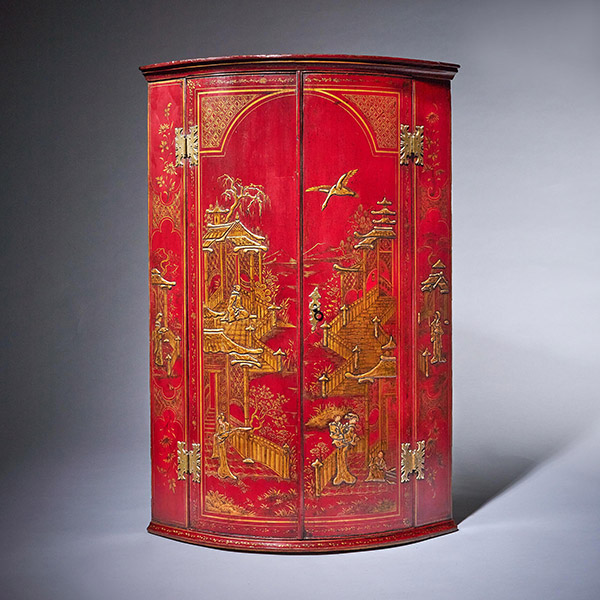
18th Century George II Scarlet-Red Japanned Corner Cupboard Att. Giles Grendey
18th Century George II Scarlet/Red Japanned Corner Cupboard, Att. Giles Grendey Follow Us18th Century George II Scarlet/Red Japanned Corner Cupboard, Att. Giles Grendey A fine and rare early 18th century George II scarlet japanned chinoiserie...

Signed Mid 19th C. Edo/Meiji Period Diminutive Lacquer Stacking Cabinet, Japan
Signed Mid 19th C. Edo/Meiji Period Diminutive Lacquer Stacking Cabinet, Japan £5,800Follow UsSigned Mid 19th C. Edo/Meiji Period Diminutive Lacquer Stacking Cabinet, Japan The highly decorated tray in the form of a table frames a series of...

Late Edo Period 19th Century Japanese Pillar Clock, Shaku-Dokei, C. 1820
Late Edo Period 19th Century Japanese Pillar Clock, Shaku-Dokei, C. 1820 £6,500Follow UsLate Edo Period 19th Century Japanese Pillar Clock, Shaku-Dokei, C. 1820 ELEGANT JAPANESE PILLAR CLOCK, 'SHAKU-DOKEI', c. 1820 The very fine 30-hour,...
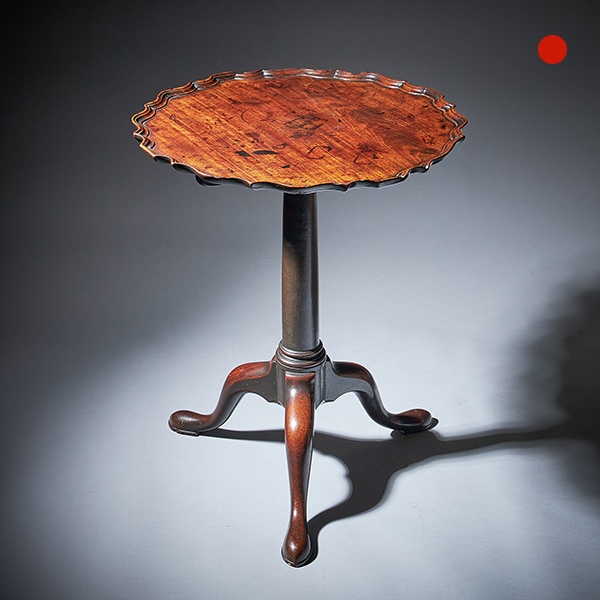
George II Gun Barrel Mahogany Tripod Table, circa 1740-1750
George II Gun Barrel Mahogany Tripod Table, circa 1740-1750 SoldFollow UsGeorge II Gun Barrel Mahogany Tripod Table, circa 1740-1750 George II Gun Barrel Mahogany Tripod table. The well-figured top has a pie crust edge, resting on a gun...
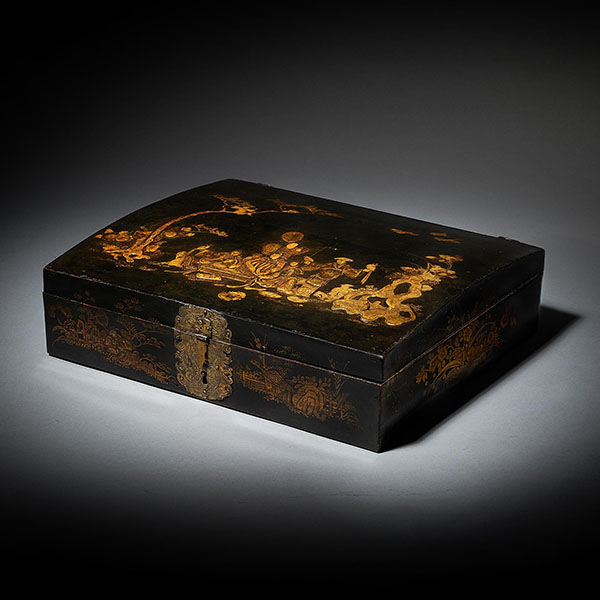
18th Century George I Domed Topped Japanned Chinoiserie Falconry Box
18th Century George I Domed Topped Japanned Chinoiserie Falconry Box, circa 1710 £3,900Follow Us18th Century George I Domed Topped Japanned Chinoiserie Falconry Box, circa 1710 A rare and important Queen Anne - George I japanned chinoiserie...
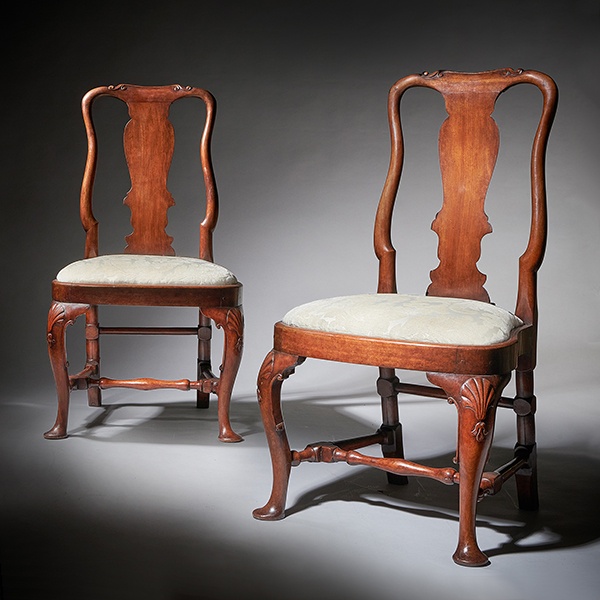
Pair of George I 18th Century Carved Mahogany Chairs, Circa 1720
Pair of George I 18th Century Carved Mahogany Chairs, Circa 1720 £4,400Follow UsPair of George I 18th Century Carved Mahogany Chairs, Circa 1720 A superb pair of early 18th-century carved George I mahogany chairs, circa 1720. Each chair is of...

18th Century George II Scarlet-Red Japanned Corner Cupboard Att. Giles Grendey
18th Century George II Scarlet/Red Japanned Corner Cupboard, Att. Giles Grendey Follow Us18th Century George II Scarlet/Red Japanned Corner Cupboard, Att. Giles Grendey A fine and rare early 18th century George II scarlet japanned chinoiserie...

Signed Mid 19th C. Edo/Meiji Period Diminutive Lacquer Stacking Cabinet, Japan
Signed Mid 19th C. Edo/Meiji Period Diminutive Lacquer Stacking Cabinet, Japan £5,800Follow UsSigned Mid 19th C. Edo/Meiji Period Diminutive Lacquer Stacking Cabinet, Japan The highly decorated tray in the form of a table frames a series of...

Late Edo Period 19th Century Japanese Pillar Clock, Shaku-Dokei, C. 1820
Late Edo Period 19th Century Japanese Pillar Clock, Shaku-Dokei, C. 1820 £6,500Follow UsLate Edo Period 19th Century Japanese Pillar Clock, Shaku-Dokei, C. 1820 ELEGANT JAPANESE PILLAR CLOCK, 'SHAKU-DOKEI', c. 1820 The very fine 30-hour,...

George II Gun Barrel Mahogany Tripod Table, circa 1740-1750
George II Gun Barrel Mahogany Tripod Table, circa 1740-1750 SoldFollow UsGeorge II Gun Barrel Mahogany Tripod Table, circa 1740-1750 George II Gun Barrel Mahogany Tripod table. The well-figured top has a pie crust edge, resting on a gun...

18th Century George I Domed Topped Japanned Chinoiserie Falconry Box
18th Century George I Domed Topped Japanned Chinoiserie Falconry Box, circa 1710 £3,900Follow Us18th Century George I Domed Topped Japanned Chinoiserie Falconry Box, circa 1710 A rare and important Queen Anne - George I japanned chinoiserie...

Pair of George I 18th Century Carved Mahogany Chairs, Circa 1720
Pair of George I 18th Century Carved Mahogany Chairs, Circa 1720 £4,400Follow UsPair of George I 18th Century Carved Mahogany Chairs, Circa 1720 A superb pair of early 18th-century carved George I mahogany chairs, circa 1720. Each chair is of...




